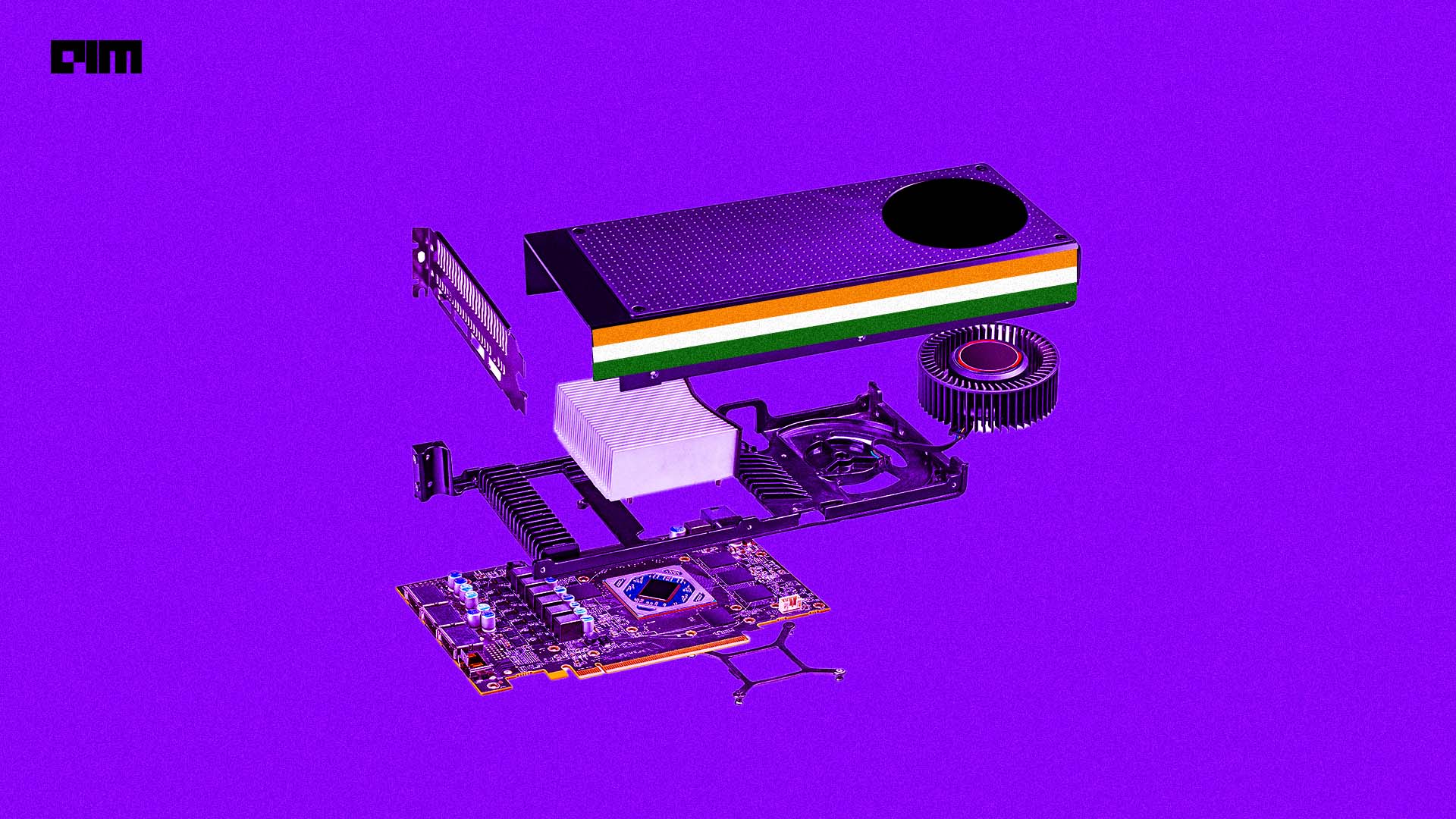|
Listen to this story
|
Indian Prime Minister Narendra Modi, while speaking at the Responsible AI for Social Empowerment (RAISE) 2020 summit, said he wants the country to become an AI hub, however, one of the major drivers of AI, besides data, is compute. For example, the supercomputer hosted in Microsoft Azure, specifically designed for OpenAI, incorporates thousands of NVIDIA Graphics Processing Units (GPUs) to power AI workloads and accelerate training processes. But, currently, the global AI industry is facing a shortage of these GPUs.
The market shortage is significant to the extent that even NVIDIA’s planned production of 2 million GPUs for 2024 is already sold out. Today, not just AI labs but different organisations and countries are trying to get their hands on these GPUs. The UK Prime Minister Rishi Sunak is planning to spend USD 126.3 million to buy AI chips as a part of the country’s plans to improve its AI resources and become a leader in AI. Reportedly, his administration is already in talks with major AI chip makers such as NVIDIA, AMD and Intel.
Given India’s ambitions in AI, the shortage could have both short-term and long-term implications for India. Moreover, owing to the intricate nature of GPUs, they can become entwined with geopolitics. For instance, the US government’s imposition of export controls prevents NVIDIA from selling its AI chips to China. Considering the industry’s heavy dependence on NVIDIA’s near-monopoly in the GPU market, could amassing GPUs, like the UK, emerge as a rational move for India?
Will the GPU crisis impact Indian companies?
In India, there are numerous startups and large organisations working on or deploying AI models at different levels. Today we are in the age of generative AI. Its explosive growth, which involves training complex models that require significant computational power, has led to a surge in demand for AI-focused GPUs. In India, a host of companies have built or are in the process of building proprietary Large Language Models (LLM).
Leena AI, which is a conversational AI-backed platform, has developed WorkLM, the company’s proprietary LLM built especially for enterprise employee experience. In a previous interaction with AIM, Mayank Kumar, co-founder & managing director at upGrad said that the edtech firm is exploring the idea of building its own proprietary LLM. Similarly, Indian IT giant Tech Mahindra is already building an Indic-LLM that would have the ability to converse in over 40 Indic languages.
Moreover, there are over 4000 AI startups in India, according to Tracxn. Given the number will only increase in the coming years, the computing power required to train models will also increase significantly. Even though Indian firms can rely on hyperscalers like AWS and Azure for computational power, buying GPUs brings significant advantages. In such a case, larger companies may find it relatively easier to acquire GPUs, but smaller businesses might face challenges in obtaining them. Pawan Prabhat co-founder of Shorthills AI believes the government buying GPUs might not be the right idea because, historically, India has done better in sectors where the government has had less control. “Rather it can help software companies offset the increased costs by giving some tax exemptions on purchases of GPUs physically or in the cloud for a limited period. Just like we have tax policies and SOPs to support startups, the government can be of help indirectly,” he told AIM.
However, Ranjan Chopra, managing director and chief executive officer at Team Computers believes the Indian government should consider allocating funds to acquire GPUs to advance its AI ambitions. If the government makes such an investment, it would align perfectly with India’s vision for technological leadership, fostering innovation, driving economic growth, and ensuring competitiveness in the global AI landscape. “Such a strategic investment not only accelerates AI progress but can also position India as an innovative powerhouse, supporting startups, fostering economic growth, and strengthening our global AI leadership,” he told AIM.
GPUs are the backbone of AI Research
Moreover, for India to achieve leadership in AI, it must place a substantial emphasis on AI research, a critical component of which is GPUs. The government has established the National Research Foundation (NRF) with the aim of enhancing research efforts in the nation, including the field of AI research. In a previous interaction with AIM, Prof. Arnab Bhattacharya, Dept of Computer Science & Engineering, IIT Kanpur, said that AI researchers in India often struggle with funds required to buy hardware such as GPUs/TPUs.
Currently, there are AI supercomputers like AIRAWAT, powered by NVIDIA DGX A100 GPUs, empowering researchers in India. Nonetheless, in the future, the demand for computational power is anticipated to increase significantly. In this light, the government has announced plans to develop nine more supercomputers in the country. However, the requirement for supercomputers in the country is diverse, hence, we can hope a portion of the new supercomputers will be dedicated towards AI research.
Kesava Reddy, CRO at E2E Networks told AIM that the government can explore strategies like bulk purchasing to subsidise the cost of GPUs for research and development purposes. “Potentially a PPP (Public-Private Partnership) model can be explored to make GPUs more accessible and affordable for AI research. This can potentially be done in collaboration with local Cloud Service Providers (CSPs), who enable the Indian market and are being used by local startups and enterprises.”
Furthermore, startups who are building generative AI technologies can also benefit from this. “Using money to get GPUs can help Indian AI startups and research projects have the right tools for their work. But we should also aim to make GPUs here in India, so we don’t have to rely on others in the long term,” Vaibhav Srivastava, senior information security analyst/ marketing Lead at Innefu Labs, told AIM.
Making India self-reliant
Similar to India’s focus on becoming self-reliant in semiconductors, the question that arises is should India aim to become self-reliant in AI hardware as well? Similar to the US-China scenario, if tomorrow, the US forbids NVIDIA from shipping chips to India, it could become a potential crisis.
Hence, “I strongly advocate that India should prioritise the local production of GPUs and AI chips, akin to the strategic focus on semiconductor manufacturing. Local production offers several strategic advantages. Firstly, it reduces India’s reliance on international markets, ensuring a more dependable supply. Recent global supply chain disruptions underscore the need for self-reliance in critical technology components,” Chopra said.
Reddy also believes with India’s focus on ‘Make in India’, and local manufacturing, building a domestic industry for GPUs and AI chips can be a powerful long-term strategy. Much like the USD 10 billion Production-Linked Incentive (PLI) scheme for semiconductors, the government could entice industry giants such as NVIDIA and AMD to establish manufacturing units within the nation.
But Prabhat, on the other hand, is of the opinion that making a GPU or an AI chip at this point in time will be a tall order. India is trying its hand at creating a fab and it might not be a good idea to get into creating AI hardware right now. “India has traditionally been very strong in software and given that we are also far off from creating a cloud infrastructure company like AWS, Azure, etc., it might be a better idea to collaborate with these chip companies and cloud companies to help them set up their units in India. In due time, we can also create our own GPU/ AI chips.” But in the short-term, the biggest leverage would potentially come from figuring out ways through which local startups and businesses can access advanced GPUs, Reddy said.



















































































